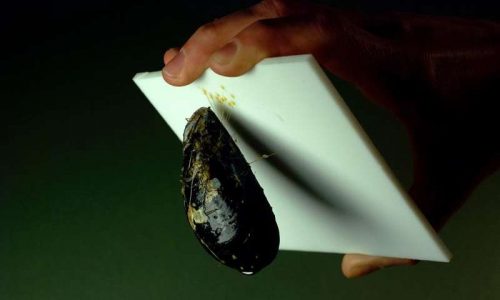【Gaofenzi.org新涂料进展】船舶防污涂料一直是一个重要的研究课题,海洋中生物,比如藤壶、牡蛎和贻贝等具有生物黏附性,如果黏附在船舶表面生长极可能腐蚀船体又为船舶增加不少重量提高船舶运行耗能,其中船舶防污的一种方法是通过释放有害物质杀死这些生物。
而最近科研人员从海洋生物黏附船舶机制发出,提出了一种新型更加环保的方法制备船舶防污涂料。科研人员研究发现像贻贝这类生物能够强力黏附在表面是因为其分泌的蛋白物质通过一种氧化交联机制形成胶,所以使其具备很强的黏附性,即使是在表面能很低的含氟材料上,下图所示是贻贝牢牢地黏附在聚四氟乙烯薄片上:

理解了这种黏附的机制后,研究人员于是提出了一种想法:在船舶涂料中添加抗氧化剂,以阻止这些生物分泌的蛋白物质氧化交联成胶。经过研究发现这一方法行之有效,与对照组比较,加入抗氧化剂的涂料明显降低了生物黏附性。
参考文献:Managing Redox Chemistry To Deter Marine Biological Adhesion,Chelsey A. Del Grosso†, Thoms W. McCarthy†, Christopher L. Clark†, Joshua L. Cloud†, and Jonathan J. Wilker*†‡,Chem. Mater., 2016, 28 (18), pp 6791–6796
With global shipping accounting for 3.5% of annual fossil fuel use, we have incentive to keep hulls clean from encrusting foulers including barnacles, oysters, and mussels. Current antifouling coatings function by releasing biocidal copper into the surrounding waters. Rather than poisoning the oceans, environmentally benign approaches to defeating biological adhesion are in great demand. Recent chemical characterization insights have found that oxidative cross-linking of proteins plays a potentially key role in the formation of several bioadhesives. Here, antioxidant compounds were placed into coatings in order to quench oxidative chemistry and inhibit glue formation. Antioxidant-containing surfaces decreased mussel adhesion relative to controls. Attacking the mechanisms of biological adhesion may provide us with a new strategy for foul release coatings and minimize the environmental impacts of shipping.
微信回复“胶黏剂”或“涂料”可阅读更多精彩内容。